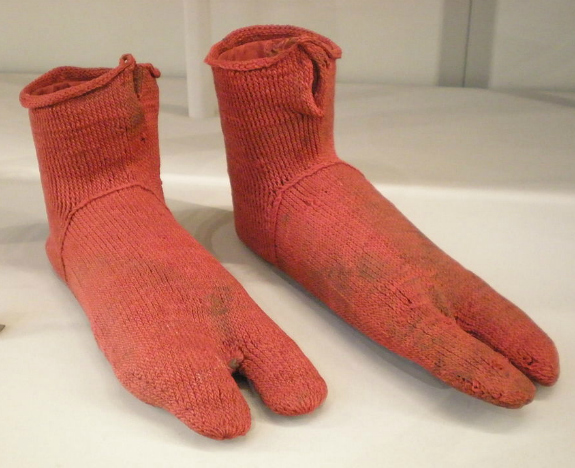Taking a Closer Look at an Odd Pair of Very, Very Old Socks
With their divided toes and extreme length, these red knit wonders from an excavated Egyptian site have an otherworldly quality
![]()
I can’t stop staring at these socks. A pair of very, very old socks made in Egypt sometime between A.D. 250 and A.D. 420.
While putting together Threaded’s Stocking Series (Parts 1, 2, 3, and 4), I did a double take when I came upon this different type of foot covering. Maybe it’s the angle of the photo, or the split toe style meant to be worn with sandals, but they’re disorienting, right? They don’t look 1,600 years old, but they don’t look new either. And they’re bright red! I don’t expect something that’s over 1,000 years old to look so vibrant. Maybe, too, it’s the size. They’re so long that they look as if they could fit Shaquille O’Neal’s famous size 23 feet—if his feet were also really narrow. After I incredulously posted this image on Facebook this past week and remarked on the antiquity’s unique qualities, a friend most succinctly responded with just: #ancientaliens.
But let’s get serious for a minute. These socks, and their provenance, can be found at the Victoria and Albert Museum:
The Romano-Egyptian socks were excavated in the burial grounds of ancient Oxyrhynchus, a Greek colony on the Nile in central Egypt at the end of the 19th century. They were given to the Museum in 1900 by Robert Taylor Esq., ‘Kytes,’ Watford. He was executor of the estate of the late Major Myers and these items were selected among others from a list of textiles as ‘a large number of very useful examples.’
Particularly intriguing about these “very useful examples” is the technique used to construct these red wool socks. Called nålbindning, or single-needle knitting, this time-consuming process required only a single thread. The technique was frequently used for close-fitting garments for the head, feet and hands because of its elastic qualities. Primarily from prehistoric times, nålbindning came before the two-needle knitting that’s standard today; each needle was crafted from wood or bone that was “flat, blunt and between 6 -10 cm long, relatively large-eyed at one end or the eye is near the middle.”
We don’t know for sure whether these socks were for everyday use, worn with a pair of sandals to do the ancient Egyptian equivalent of running errands or heading to work—or if they were used as ceremonial offerings to the dead (they were found by burial grounds, after all). I prefer to imagine an #ancientalien pulling them on to protect its E.T.-like feet from the extraterrestrial elements.
/https://tf-cmsv2-smithsonianmag-media.s3.amazonaws.com/accounts/headshot/emily-spivack-240.jpg)

/https://tf-cmsv2-smithsonianmag-media.s3.amazonaws.com/accounts/headshot/emily-spivack-240.jpg)